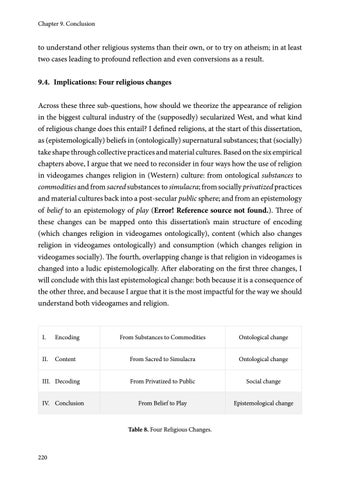Chapter 9. Conclusion
to understand other religious systems than their own, or to try on atheism; in at least two cases leading to profound reflection and even conversions as a result. 9.4. Implications: Four religious changes Across these three sub-questions, how should we theorize the appearance of religion in the biggest cultural industry of the (supposedly) secularized West, and what kind of religious change does this entail? I defined religions, at the start of this dissertation, as (epistemologically) beliefs in (ontologically) supernatural substances; that (socially) take shape through collective practices and material cultures. Based on the six empirical chapters above, I argue that we need to reconsider in four ways how the use of religion in videogames changes religion in (Western) culture: from ontological substances to commodities and from sacred substances to simulacra; from socially privatized practices and material cultures back into a post-secular public sphere; and from an epistemology of belief to an epistemology of play (Error! Reference source not found.). Three of these changes can be mapped onto this dissertation’s main structure of encoding (which changes religion in videogames ontologically), content (which also changes religion in videogames ontologically) and consumption (which changes religion in videogames socially). The fourth, overlapping change is that religion in videogames is changed into a ludic epistemologically. After elaborating on the first three changes, I will conclude with this last epistemological change: both because it is a consequence of the other three, and because I argue that it is the most impactful for the way we should understand both videogames and religion.
I.
Encoding
From Substances to Commodities
Ontological change
II. Content
From Sacred to Simulacra
Ontological change
III. Decoding
From Privatized to Public
Social change
From Belief to Play
Epistemological change
IV. Conclusion
Table 8. Four Religious Changes.
220
